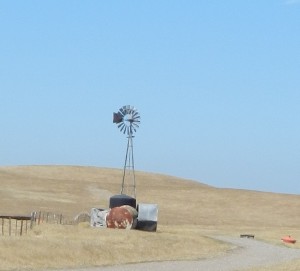
With a history dating back over 2,000 years, the windmill represents one of man’s most enduring mechanical contrivances. There are few images more representative of the arid American west. It’s a clean-energy, labor-saving device older than the terms that describe it.
Given 15-to-20 mile an hour winds, an 8-foot diameter windmill can pump around 150 gallons an hour. An average family of four might use 200 to 300 gallons of water a day, so 150 gallons an hour is, by at least one measure, a lot of water.
While it’s not uncommon to see windmills next to houses, they’re also often the only landmarks in the long stretches of desolate rangeland that typify much of the American west. Oftentimes, the presence of a windmill indicates the presence of cattle, whose thirsts are quenched with groundwater pumped by the trusty wind machines.
There was a time when windmills were common along the dry edges of the San Joaquin Valley. Cattle ranchers and cowboys headed for the hills after they were crowded off the Valley floor.
Today, even in the foothills, windmills and cattle ranchers are going the way of hitching posts and rawhide lariats. Once, disappearing windmills might have been attributed to housing tracts and strip malls. Today, almond orchards are a bigger factor in lost rangeland than developers .
According to a recent study, the San Joaquin Valley lost the most rangeland in the entire state in the last two decades, and 54% of the conversion was to agricultural uses. Once brown and sere, the foothills have turned green and moist.
The source of the moisture is an underground storage system of almost incalculable value—some of the last untapped groundwater in the state. Fed by aquifers filled with water thousands of years old, foothills groundwater is proving a bonanza for investors with enough front money to afford the acreage, trees, and industrial-sized pumps necessary to turn dry rangeland into verdant orchards.
Compared to the stately windmills, the new pumps are unimposing things, squat and hardly noticeable. Because of their remote locations, most run on diesel fuel; electricity isn’t available.
The unimposing nature of the pumps, the invisibility of groundwater, and the hidden delivery system of drip irrigation keep groundwater out of sight and out of mind. That’s one reason it’s so susceptible to overuse. Entire lakes and reservoirs of the stuff can be pumped onto large orchard tracts and almost no one sees the water.
Consider it this way: At full capacity, Modesto Reservoir, which stores drinking water for the city of Modesto, holds 29,000 acre feet of water. That’s barely enough water for 10,000 acres of almonds for one year. But 10,000 acres of almonds is a mere fraction of the acreage that’s been added to Valley foothills in recent years. The new almond inventory needs hundreds of thousands of acre feet of water year after year after year.
And that’s why the new pumps, squat and unimposing as they are, are capable of spreading 2500 gallons a minute over the land around them. Figure there are hundreds of these pumps in Stanislaus County alone, and you begin to get some sense of just how much water is being taken from the ground.
Experts agree it’s water that won’t be replaced any time soon. It took thousands of years to create the foothills aquifers, but modern technology will drain them in couple of decades. For some, that’s progress. Others might think we were wiser using windmills for cattle and rangeland.

Sounds like you need a windmill tour. I know just the person to do it! Some of the issues are 1) getting people qualified to repair them (not an easily-learned skill); 2) finding parts to repair them (another major challenge) and 3) many are being replaced with solar panels and pumps which are more readily available these days, easier to install and repair, and still provide water when the wind doesn’t blow. Remember that cattle will drink upwards of 20 gals./head/day.
I once suggested to an almond grower that a very simple “good-neighbor policy” (we have it with the turkey ranches on our home ranch) is to simply run a 3/4″ or 1″ fresh water pipeline and a water trough for your neighbor. In our case, we hooked into the wells needed for the turkeys. It goes a LONG way toward peace & quiet and comfort and it also provides security – especially in times like this.
If you watch cattle, they are creatures of habit. They will be in certain parts of the field during certain parts of the day. In the summer, they’ll feed in the evening and early morning then hang out by water during the heat of the day. Same goes for when you gather them – they tend to have to go through their daily routine before you can alter it. When we would early-morning gather, they had to go to the stockpond first, then we could drive them to the corrals to work them. Drive them the shortest distance – no way. They still had to go to the pond first. Much less stress on them and yourself. One other thing about the windmill or stockpond is that it’s a bovine social spot – it’s a good place to lay around, swat flies and chew your cud.
Thanks Tom. We love comments from experts, and I can’t think of anyone who knows more about ag and ag issues than you do. I would love the windmill tour. Lemme know when and where to be.
The information in this article is astounding. Obviously, current water use practices are not sustainable. When the wells run dry, the pain will come swiftly.
Given the great increase in vegetation transpiration, the cumulative effect must be contributing to climate change in some manner. One may wonder whether the moisture is feeding the larger storms hitting Nevada and parts to the east and adding to the drought problems we have here. Maybe the alterations being made are not having a significant effect on our climate. As everything on earth is interconnected in same way, logic dictates that the environmental changes are having an effect. In Africa, land use by man has been linked to the growth of the Sahara desert. What are we accomplishing in North America with our land use?